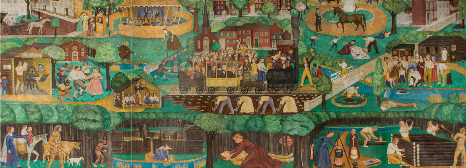You have /5 articles left.
Sign up for a free account or log in.
As colleges and universities continue to debate issues of race on campus, Tuesday saw several developments. At Kean University, authorities said a threat against black students turns out to have been a hoax. At Harvard University, the leaders of the residential colleges unanimously announced that they will stop using the title "master." And in Kentucky, a literary legend is coming to the defense of a mural that the University of Kentucky recently covered up because it offended black students.
A Fake Threat at Kean
Many at Kean University were alarmed by threats that appeared on Twitter last month from an account (which quickly disappeared) called @keanuagainstblk. Tweets from the account threatened to shoot black students or place a bomb at the university. A coalition of black ministers called for the resignation of President Dawood Farahi, saying he had not responded sufficiently to the threats.
 On Tuesday, New Jersey authorities charged a recent graduate, a black woman who was involved with the campus protests over the treatment of black students, with making the threats. According to prosecutors, Kayla-Simone McKelvey (at right) was at a rally of black students on Nov. 17, and "left the rally midway through and walked to a computer station located in a university library. Once there, McKelvey allegedly created an anonymous Twitter account and began posting racially charged threats of violence against black Kean students. After making the posts, McKelvey immediately returned to the rally and attempted to spread awareness of the threats she allegedly had just fabricated."
On Tuesday, New Jersey authorities charged a recent graduate, a black woman who was involved with the campus protests over the treatment of black students, with making the threats. According to prosecutors, Kayla-Simone McKelvey (at right) was at a rally of black students on Nov. 17, and "left the rally midway through and walked to a computer station located in a university library. Once there, McKelvey allegedly created an anonymous Twitter account and began posting racially charged threats of violence against black Kean students. After making the posts, McKelvey immediately returned to the rally and attempted to spread awareness of the threats she allegedly had just fabricated."
McKelvey, who could not be reached for comment, has been charged with a single count of third-degree creating a false public alarm. Authorities said McKelvey never intended to harm students.
Farahi, the Kean president, issued this statement: "We are saddened to learn that the person allegedly responsible was an active participant in the rally that took place on campus on Tuesday, Nov. 17, and is a former student of Kean. As a diverse academic community, we wholeheartedly respect and support activism, however, no cause or issue gives anyone the right to threaten the safety of others. We hope this information will begin to bring a sense of relief and security to the campus community."
End to a Title at Harvard
At Harvard on Tuesday, at a faculty meeting, the dean of Harvard College, Rakesh Khurana, announced that those who hold the title of "master" in the institution's residential colleges "have unanimously expressed a desire to change their title."
His statement said that "the recommendation to change the title has been a thoughtful one, rooted in a broad effort to ensure that the college's rhetoric, expectations and practices around our historically unique roles reflects and serves the 21st-century needs of residential student life."
He said that a process would now start to come up with a new name. Students at a number of universities that use the title have in recent weeks objecting to it, saying that it suggests "master" in the sense of slavery. In the context of leading an academic unit, the term actually predates American slavery, but the title has become a flash point.
Princeton University announced last month that it would drop the term and instead refer to those leading its residential colleges as "head of the college."
Sit-In Ends at Brandeis
A 12-day sit-in at Brandeis University ended Tuesday. Protesting students left an administration building they have been occupying after the university released details on expanded efforts to promote diversity and inclusiveness.
Among the pledges in the document:
- Plans to double the number of underrepresented minority faculty members by 2021. Among the steps the university will take are "expanding outreach to underrepresented candidates of color" and "training all search chairs and diversity representatives on search committees on implicit bias."
- Expanded efforts to recruit minority students through new relationships with community colleges and other steps to increase the number of minority applications by 5 to 10 percent annually.
- A review of the curriculum that will include "consideration of how to incorporate issues of race, equity and inclusion in university requirements. This process will include a comprehensive audit of the curriculum across departments and schools to identify what is currently offered (and when) on issues of issues of race, equity and inclusion."
- Efforts to promote inclusiveness for all students. The statement ended by saying: "In protecting all groups from discrimination and harassment, we recognize that certain members of our community, especially black women, sit at the intersection of certain forms of violence, threats, intimidation and harm. In order to uplift all those who occupy the most vulnerable space in our community, we must understand the structures that disproportionately impact them. Over the past week our students articulated the impact of exclusion on their Brandeis experience in ways that were startling and disturbing. With their voices in mind, we remain hopeful that we can and will emerge from recent events as a stronger, more inclusive institution recommitted to our founding values."
Defending a Mural
Wendell Berry is a poet, essayist and environmentalist -- and among the leading literary figures in Kentucky. He has published an essay criticizing the University of Kentucky for covering up (with plans to move) a mural on the history of the state.
 The university announced last month that it would cover the mural (at right) in response to complaints from many black students, who have objected to the way the mural depicts black people (slaves) working in tobacco fields, black musicians performing for a group of white people and a Native American holding a tomahawk. The mural -- produced in the Depression-era Public Works of Art program -- is in a prominent building, such that many students walk by it all the time.
The university announced last month that it would cover the mural (at right) in response to complaints from many black students, who have objected to the way the mural depicts black people (slaves) working in tobacco fields, black musicians performing for a group of white people and a Native American holding a tomahawk. The mural -- produced in the Depression-era Public Works of Art program -- is in a prominent building, such that many students walk by it all the time.
The mural, said President Eli Capilouto in announcing the decision, "provides a sanitized image of that history. The irony is that artistic talent actually painted over the stark reality of unimaginable brutality, pain and suffering."
But Berry disagrees. In his essay he argues that the artist, Ann Rice O’Hanlon, showed courage by including slaves in the history at a time that many would have left them out completely. (Berry also notes that O'Hanlon was the aunt of his wife.) Further, he writes that the mural shows the black people to have been oppressed and does not glorify that.
"If forgetting history is now the purpose of higher education, I may be taking some risk by reminding the flagship censors of the persecution of Boris Pasternak by Soviet officials when Dr. Zhivago was published in the West and awarded the Nobel Prize. I will go further into danger and remind them also that Thomas Merton wrote a brilliant appreciation of that novel and its author. Among much else of value Merton said this: 'It is characteristic of the singular logic of Stalinist-Marxism that when it incorrectly diagnoses some phenomenon as "political," it corrects the error by forcing the thing to become political,'" Berry writes. "The fresco in Memorial Hall was, in its origin and in itself, not political. Now, by the singular logic of the university’s official righteousness, it has been forced to become political."








